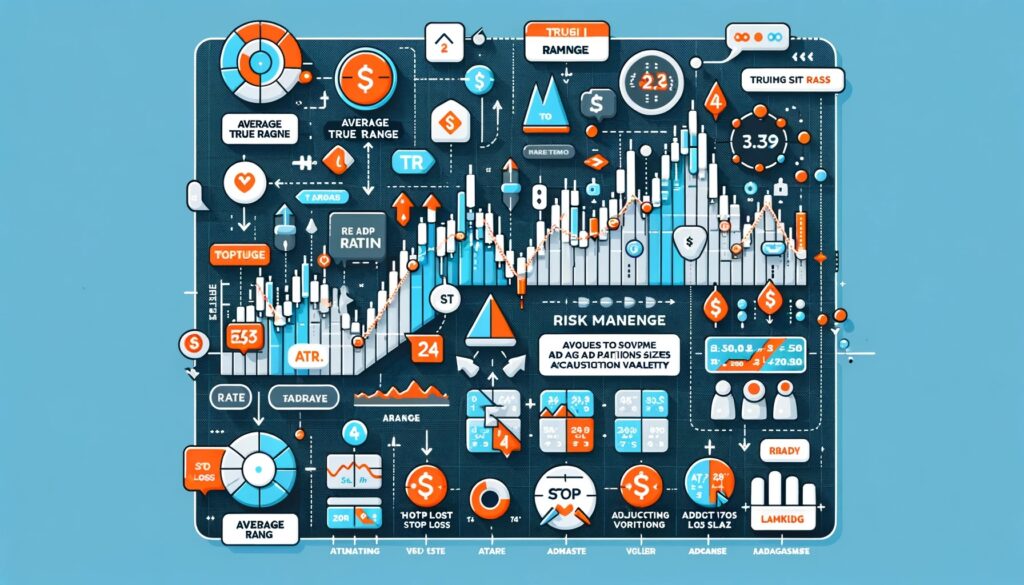In the world of Forex trading, where uncertainty is the only certainty, effective risk management strategies are the lifeline of every successful trader. Among the plethora of tools available for managing risk, the Average True Range (ATR) distinguishes itself as a versatile and indispensable indicator. Developed by Welles Wilder, the ATR measures market volatility, providing traders with critical insights to refine their risk management tactics. This comprehensive guide delves into the practical application of ATR in Forex trading, illustrating its importance in setting stop-loss orders, optimizing position sizing, and ultimately safeguarding your trading capital.

Understanding the Average True Range (ATR)
The ATR indicator offers a dynamic perspective on the market’s volatility by calculating the average price range over a specified period. Unlike static measures of volatility, the ATR adjusts to the market’s changing conditions, making it an invaluable tool for Forex traders who need to adapt their strategies to varying levels of market activity.
Calculating the Average True Range (ATR)
The ATR is computed by taking the moving average of the true ranges for a predetermined number of periods, typically 14 days. The true range for a given period is the greatest of the following:
- The difference between the current high and low.
- The difference between the previous close and the current high.
- The difference between the previous close and the current low.
This calculation provides a nuanced view of market volatility, capturing gaps and limit moves that other indicators might miss.
Interpreting Average True Range (ATR) Values
A higher ATR value indicates increased market volatility, signaling larger price movements that could either present significant trading opportunities or pose a greater risk. Conversely, a lower ATR suggests a more stable market, with smaller price movements and potentially lower trading risk.

Applying Average True Range (ATR) in Forex Risk Management
Setting Stop-Loss Orders with ATR
One of the most critical applications of the ATR in Forex trading is in setting stop-loss orders. A well-placed stop-loss can prevent substantial losses by automatically closing a position when the market moves unfavorably.
Example of Stop-Loss Placement Using ATR
Consider a trader planning to enter a long position on the GBP/USD pair. If the current ATR value is 0.0090 (90 pips), the trader might decide to set a stop-loss order 1.5 times the ATR below the entry point. This strategy ensures that the stop-loss is based on the pair’s current volatility, reducing the risk of being stopped out prematurely due to normal market fluctuations.
Optimizing Position Sizing Using ATR
Another critical use of the ATR is in determining position size. By accounting for the market’s volatility, traders can adjust their position sizes to maintain consistent risk levels across all trades.
Position Sizing Example with ATR
If a trader is willing to risk $300 on a trade, and the chosen stop-loss is 135 pips away (1.5 times an ATR of 90 pips), the maximum position size can be calculated by dividing the risk amount by the stop-loss distance in dollar terms. This calculation ensures that the trader does not exceed the predetermined risk level, regardless of the market’s volatility.

Average True Range (ATR) in Action: A Forex Trading Scenario
Let’s apply the ATR to a practical Forex trading scenario involving the EUR/USD pair. Suppose the current ATR value is 0.0080 (80 pips), indicating the pair’s average price movement over the selected period.
A trader observing a bullish signal decides to enter a long position at 1.1500, with a risk tolerance of $200 per trade. Using the ATR to guide stop-loss placement, the trader sets the stop-loss 1.5 ATR (120 pips) below the entry point, at 1.1380, to accommodate the pair’s volatility.
To calculate the optimal position size, the trader divides the risk amount ($200) by the stop-loss distance in dollar terms. This calculation ensures that the trade aligns with the trader’s risk management strategy, balancing the potential for profit with the imperative of capital preservation.

Conclusion: Maximizing Forex Trading Success with ATR
The Average True Range (ATR) is more than just a measure of market volatility; it’s a critical component of a comprehensive Forex trading and risk management strategy. By using the ATR to inform stop-loss placements and position sizing, traders can tailor their approaches to the current market conditions, optimizing their potential for success while minimizing risk.
In the unpredictable Forex market, where volatility is the only constant, the ATR emerges as a beacon of clarity, guiding traders through the tumultuous waters of currency trading. Whether you’re a novice trader seeking to protect your capital or an experienced market participant looking to refine your strategies, incorporating the ATR into your trading toolkit can provide the edge you need to navigate the complexities of the Forex market with confidence and precision.

FAQs About Using ATR for Risk Management in Forex Trading
What is the Average True Range (ATR) indicator?
The Average True Range (ATR) is a technical analysis indicator used to measure market volatility. It calculates the average range of price movements over a specified period, typically 14 days, helping traders understand the volatility of the currency pairs they are trading.
How can ATR be used in setting stop-loss orders?
ATR helps in setting stop-loss orders by providing a measure of market volatility. Traders can multiply the ATR by a certain factor, such as 1.5 or 2, to determine an appropriate distance from the entry point to set a stop-loss. This method ensures that the stop-loss is based on current market conditions, reducing the likelihood of being stopped out by normal price fluctuations.
Can ATR help in determining position size in Forex trading?
Yes, ATR is an excellent tool for determining position size. By considering the level of volatility, traders can adjust their position size to maintain a consistent risk level across all trades. The formula involves dividing the maximum dollar amount a trader is willing to risk by the ATR-adjusted stop-loss distance, giving a position size that aligns with the trader’s risk management strategy.
Is ATR suitable for short-term or long-term trading strategies?
ATR can be adapted for both short-term and long-term trading strategies. Short-term traders might use a lower period setting for ATR to respond quickly to market changes, while long-term traders might prefer a higher period setting to filter out short-term volatility and focus on longer-term trends.
How does ATR differ from other volatility indicators?
Unlike other volatility indicators that might only consider the high and low or the closing prices, ATR includes the entire range of price movements, including gaps and limit moves. This comprehensive approach provides a more accurate measure of market volatility, making it a valuable tool for assessing risk.
What are the limitations of using ATR in Forex trading?
While ATR is a powerful indicator for assessing market volatility, it does not predict market direction or future price movements. It should be used in conjunction with other analysis tools and within a comprehensive trading strategy to manage risk effectively. Additionally, ATR may lag during rapidly changing market conditions.
How can traders adjust the sensitivity of the ATR indicator?
Traders can adjust the sensitivity of the ATR indicator by changing the period over which it is calculated. A lower period setting will make the ATR more sensitive to recent price changes, while a higher period setting will make it less sensitive, providing a smoother measure of volatility.
Does ATR account for the direction of the market movement?
No, ATR does not differentiate between upward or downward market movements. It solely measures the magnitude of price movements (volatility) without considering the direction. Traders should use other indicators or analysis methods to determine market direction.
Can Average True Range (ATR) be used across different time frames?
Yes, ATR can be applied across various time frames, from intraday to daily, weekly, or monthly charts. The choice of time frame depends on the trader’s strategy and the level of detail they need to assess market volatility and manage risk.
How should traders incorporate Average True Range (ATR) into their trading plan?
Traders should incorporate ATR into their trading plan by using it to adjust stop-loss settings and position sizes based on current market volatility. It’s important to integrate ATR with other technical analysis tools and fundamental analysis to make well-rounded trading decisions. Regular review and adjustment of the ATR settings may also be necessary to align with changing market conditions.





